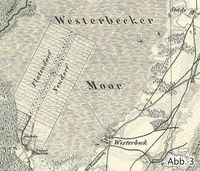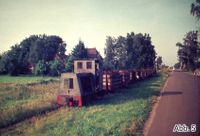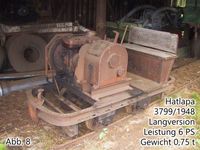Transport – the solution to all problem
To another planet or to Gifhorn – transport is the decisive factor. Only a few paths crossed the moor. Building paths across the moor was difficult with the means available at the time. No path could hold a heavy load on a bed of peat. Historical paths such as the Heudamm in Stüde, the Westerbecker Weg (Fig. 3 from 1838) and the Bräutigamsweg linked the Great Moor to the rest of the world. Rail transport was then easier.
Only two men were needed to lay lightweight tracks (Fig. 4) to the required cutting area.
Medium-strength rails were used for tracks that were in permanent operation, e.g. along the Knüppeldamm, the Dorfstraße (Fig. 5) or alongside the Heudamm in Stüde. These were all light railways.
Since 1 December 1900, a standard-gauge track of the Deutsche Bahn has been running to the west of the Neudorf-Platendorf (Fig. 6). Parallel to this was a similar track alongside the Bräutigamsweg and the moor canal there. This ran via Triangel and was connected to the track linking Gifhorn, Braunschweig and Uelzen.
Two engines were employed at the Wulfes peat works.
In the final years of operation, the Schöttler 994, which was built in 1948, was practically the only one used (Fig. 7). The body on the engine carriage was not the original. This was made necessary by the engine having to be replaced. The 11 hp of the 1-cylinder Deutz air-cooled engine was fully adequate for operation. It was strong enough to pull about 20 loaded trolleys on the flat. An incident of vandalism (sand in the oil filler neck) made it necessary to protect the engine compartment and the fuel tank with metal panels.
A certain amount of skill was needed to start the stationary engine in the Hatlapa (Fig. 8) (also known as the “Moppel” in the family-run business of the day). Factors to take into account included the fuse, the gas piston, the decompression lever, the compression point and a spirited turning of the starter crank. In the winter months, the liquid-cooled 1-piston engine always thanked the engine driver for adding some hot water from the canister before starting. The water had to be drained off completely after operation to prevent frost damage.
Those who couldn’t afford an engine had to make use of dog power (Fig. 9).
Figure 10 shows the fibric peat convoy of L. Hornburg & Co. in 1903.
Links to other stations in the museum:
<1> <2> <3> <4> <5> <6> <7> <8> <9> <10> <11> <12> <13> <14> <15> <16> <17> <18> <19> <20> <21> <22> <23>







